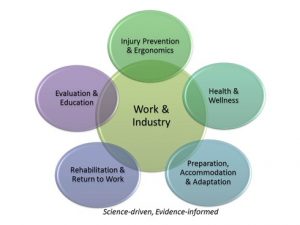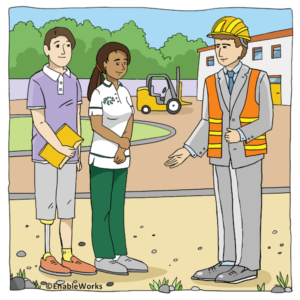

Overview of How OT as a Profession Contributes to Work Participation
The distinct value of occupational therapy is to improve health and quality of life by facilitating engagement in occupations. Work is an occupation that includes employment seeking and acquisition, job performance, retirement preparation, and volunteer exploration and participation. Occupational therapy practitioners understand the complex and dynamic interactions of the person, their habits and routines, the work demands, and the context of the work environment. This understanding enables practitioners to develop client-centered interventions to increase health and wellness, prevent disability, and facilitate participation in work activities. Occupational therapy is the only profession that looks at the whole person and provides supports to address client factors (e.g., assistive technology, ergonomics), job demands (e.g., task modifications), and environmental factors (e.g., noise levels, working conditions).
Work is a meaningful occupation that spans nearly all practice settings and populations. Occupational therapy practitioners in all settings should consider the occupation of work for clients from ages 15 to 65+ years. Examples include addressing pre-vocational and job readiness skills in school settings; return-to-work skills in inpatient and outpatient settings; and job accommodations and ergonomic considerations in the workplace.
Occupational therapy practitioners can address work in a variety of environments including, but not limited to:
* Business and industrial environments
* Acute care and rehabilitation facilities
* Mental health facilities
* Sheltered workshops or other vocational programs
* Community settings
* Outpatient clinics
* Hospitals
* Private practice
* Schools
* Public agencies
On-site evaluations and intervention
.. …
…  ..
..
Referrals come from a variety of sources requesting on-site work evaluation and intervention (e.g., physicians, case managers, other health care providers, workers’ compensation and long-term disability carriers, vocational rehabilitation agencies, and other private or public agencies) for individuals who are beginning work, desiring to remain at work following injury or disease, or returning to work after an injury or disability. These providers may also request injury prevention and health and wellness services for individuals and groups.
Examples of services provided by occupational therapy include evaluating client performance and function; evaluating work demands; identifying injury risk factors; identifying job accommodations and modifications needed to return to work; and providing work transition services, ergonomic evaluation, and injury prevention services.
Work – An area of occupation that is defined as “Labor or exertion; to make, construct, manufacture, form, fashion, or shape objects; to organize, plan, or evaluate services or processes of living or governing; committed occupations that are performed with or without financial reward” (Christiansen & Townsend, 2010, p. 423).
Work is integral to participation in society, and provides many returns to the worker including economic rewards, meaning, and fulfillment. An adverse work situation can also negatively affect quality of life and well-being. AOTA has identified Work and Industry as a key practice area in the 21st century.
1. Employment interests and pursuits- Identifying and selecting work opportunities based on assets, limitations, likes, and dislikes relative to work (adapted from Mosey, 1996, p. 342).
2. Employment seeking and acquisition- Advocating for oneself; completing, submitting, and reviewing appropriate application materials; preparing for interviews; participating in interviews and following up afterward; discussing job benefits; and finalizing negotiations.
3. Job performance- Performing the requirements of a job, including work skills and patterns; time management; relationships with coworkers, managers, and customers; leadership and supervision; creation, production, and distribution of products and services; initiation, sustainment, and completion of work; and compliance with work norms and procedures.
4. Retirement preparation and adjustment- Determining aptitudes, developing interests and skills, selecting appropriate avocational pursuits, and adjusting lifestyle in the absence of the worker role.
5. Volunteer exploration- Determining community causes, organizations, or opportunities for unpaid work in relationship to personal skills, interests, location, and time available.
6. Volunteer participation- Performing unpaid work activities for the benefit of selected causes, organizations, or facilities.
Occupational therapy practitioners promote success in the workplace by improving the fit between the person, the job tasks, and the environment. They work with employers and employees to adapt or modify the environment or task, facilitate successful return to work after illness or injury, and help prevent illness or injury to promote participation, health, productivity, and satisfaction in the workplace. They may work with children and adults with developmental and intellectual disabilities to help them prepare for work and transition into the workforce. Occupational therapy practitioners also provide services related to ergonomics, accessibility, the aging workforce, and workplace health and wellness issues.
5 categories of work (as defined by Code of Federal Regulations)
1. Sedentary work– involves lifting no more than 10 pounds at a time and occasionally lifting or carrying articles like docket files, ledgers, and small tools. Although a sedentary job is defined as one which involves sitting, a certain amount of walking and standing is often necessary in carrying out job duties. Jobs are sedentary if walking and standing are required occasionally and other sedentary criteria are met.
2. Light work– involves lifting no more than 20 pounds at a time with frequent lifting or carrying of objects weighing up to 10 pounds. Even though the weight lifted may be very little, a job is in this category when it requires a good deal of walking or standing, or when it involves sitting most of the time with some pushing and pulling of arm or leg controls. To be considered capable of performing a full or wide range of light work, you must have the ability to do substantially all of these activities. If someone can do light work, we determine that he or she can also do sedentary work, unless there are additional limiting factors such as loss of fine dexterity or inability to sit for long periods of time.
3.Medium work-
4. Heavy work– involves lifting no more than 100 pounds at a time with frequent lifting or carrying of objects weighing up to 50 pounds. If someone can do heavy work, we determine that he or she can also do medium, light, and sedentary work.
5. Very heavy work<– involves lifting objects weighing more than 100 pounds at a time with frequent lifting or carrying of objects weighing 50 pounds or more. If someone can do very heavy work, we determine that he or she can also do heavy, medium, light and sedentary work.
Occupational therapists work with employers, workers, and other healthcare professionals or team members to create and implement feasible and individualized intervention plans in the following broad areas. They also evaluate the outcomes of these interventions and make any necessary adjustments.
Acute Injury and Illness Management: The occupational therapist works with the person to determine any gaps between the demands of the job and the individual’s existing performance abilities and remediates or compensates for the differences in a timely manner.
Work Conditioning: The occupational therapist uses a systematic approach to restore the performance skills of workers recovering from long-term injury or illness. There is a focus on restoring musculoskeletal and cardiovascular systems, as well as safely performing work tasks. This is typically achieved through work simulation and individualized interventions to improve physical capacity.
Work Hardening: This approach is similar to work conditioning however, it is multidisciplinary and can involve psychomedical counseling, ergonomic evaluation, job coaching, and/or transitional work services. Persons in work-hardening programs may progress to transitional work programming by actually performing job duties at their place of employment. If necessary, final adaptations and/or reasonable accommodations can be determined during this period of transition.
Functional Capacity Evaluation (FCE): The occupational therapist uses standardized and validated advanced testing in order to (a) determine safe job matches for return to work; (b) determine the level of reasonable accommodations necessary for reinstating an injured worker; and (c) make recommendations regarding future interventions. The results of the FCE may be used by the physician to make a disability rating for insurance purposes.
Environmental Modification: The occupational therapist, together with the worker and the employer, makes recommendations for modifications to the workplace environment to facilitate successful employment performance.
Transitional Work Programs: Transitional work uses the actual work tasks and environments as a form of rehabilitation. After becoming familiar with the individual’s job requirements and measuring the individual’s functional abilities, the occupational therapist determines tasks that the individual can safely and dependably perform at work. The occupational therapist works with the employer to identify environmental and task modifications that will support work performance, and makes detailed recommendations to the treating physician, who releases the individual to modified work within these parameters. Work performance is closely monitored and discussed among the occupational therapist, employer, and individual, and modifications change as the worker develops more skills.

Occupational therapists play a vital role in helping people to gain the functional skills they need to return to work or to obtain employment.
Work performance can suffer if there are problems in any of the following areas:
1. Physical body
2. Sensation
3. Cognition
4. Perception
5. Mental health
6. Social interactions
7. Development
The following charts will review the various aspects of occupational therapy intervention in the areas of work reconditioning and vocational rehabilitation.
The Occupational Therapy Practitioner’s Role in Enabling Clients to Work
There are many aspects that therapists must consider when providing services to clients who want to return to work or who want to start working in the first place. Both OT’s and OTA’s are involved in this process.
| Role of the OT | Role of the OTA |
| ● Identify and analyze the problem. o Why is this client unable to complete their work task? o What are the demands of the client’s particular job? o What are the client’s required work tasks? o What are the work routines? o What equipment does the client normally use? o Are there any ergonomic problems and how accessible is the client’s workstation? |
● Implement the intervention plan |
| ● Identify and analyze the problem. o Why is this client unable to complete their work task? o What are the demands of the client’s particular job? o What are the client’s required work tasks? o What are the work routines? o What equipment does the client normally use? o Are there any ergonomic problems and how accessible is the client’s workstation? |
● Collect data related to the client’s performance during treatment. |
| ● Choose how to evaluate the problem (are there any assessments you can use?) | ● Document how the client is responding to treatment, including his or her ability to participate and if he or she has made progress |
| ● Come up with interventions to the address the problem | |
| ● Supervise the OTA who may be assisting with interventions |
The following factors should be considered when designing work related interventions for clients:
– Age
– Interests
– Values
– Cultural background
– Skills and abilities
– Motivation
– Mental health
– Social ability
– Role at work
– Demands of the client’s particular job
– Work environment
– Resources available to the client
Treatment for work related conditions may be provided in acute care settings, inpatient or outpatient rehabilitation units, inpatient or outpatient mental health units, at a job site, in a sheltered workshop, or at a supported employment site. Besides clients, therapists collaborate with employers, case managers, and state or local agencies to help return clients to work or transition them from school or home to employment.
Occupational therapists provide the following work-related services to both individuals or groups:
| Type of service | What is included | Example | Video |
| Consultative services | Education about the following topics: ● Injury prevention in the work place ● Stress management ● Safety ● Body mechanics and posture ● Pain management ● Joint protection techniques ● Health monitoring |
An occupational therapist presents an in-service to CNAs working in a SNF about proper body mechanics while lifting patients. | |
| Direct Services | Help to return clients to work or establish employment if clients have never worked.
Help promote and facilitate productive work abilities. Help to prevent work-related injuries or other problems. Help clients to restore skills that have been lost. Train clients how to compensate. |
An occupational therapy assistant works with a client on an upper extremity exercise program to help the client condition his body for return to work at a landscaping company. |

Work Reconditioning
Work reconditioning occurs when a person has sustained an illness or injury that has limited his or her ability to work in a physically demanding position for a prolonged period of time. To reduce the risk of further injury, the person undergoes work conditioning and/or work hardening prior to returning to a physically demanding job.
Definitions:
| Term | Definition | Example | Photo/Video |
| Work Conditioning | A program of physical exercise and endurance training designed to help a person regain the physical capabilities necessary to return to work. | An occupational therapist works with a waitress who has had a hip replacement to increase her endurance while walking and carrying a loaded tray. | |
| Work Hardening | A comprehensive program that addresses a person’s physical and psychological needs in preparation for return to work. Work hardening includes more direction during physical activities and a more individualized approach to intervention. | An occupational therapy assistant supervises a client as he clocks into his work hardening program and completes warm-up stretches prior to lifting and carrying weighted boxes. | |
| Work Simulation Activities | Functional activities designed to simulate the movement and weight lifting requirements expected of a person on an actual job. | A client in a work hardening program carries 25-pound bags from a stock pile to a pallet to simulate his job at a local feed store. |
|
| Functional Capacity Evaluation (FCE) | An evaluation of work capabilities in which a person completes a series of work simulation tasks that mimic his or her actual job in order to identify functional limitations that may prevent return to work. The occupational therapist uses standardized and validated advanced testing in order to (a) determine safe job matches for return to work; (b) determine the level of reasonable accommodations necessary for reinstating an injured worker; and (c) make recommendations regarding future interventions. The results of the FCE may be used by the physician to make a disability rating for insurance purposes. | An occupational therapist completes an FCE with a woman who has sustained a back injury while working in a paper mill. |
Comparison of Programs
The majority of people who suffer illnesses or injuries are able to return to work with no intervention or outpatient rehabilitation. Only a few require the more intensive training that work conditioning and work hardening provide. This chart will compare the similarities and differences between outpatient rehabilitation, work conditioning, and work hardening.
| Outpatient Rehabilitation | Work Conditioning | Work Hardening | Videos | |
| Focus of program | Improving range of motion, strength, and coordination of the part of the body where the injury was sustained. Improving overall functional ability to allow independent functioning during work, leisure, and self care tasks. | Improving a person’s physical strength and endurance to help that person return to work. | Improving a person’s physical strength, endurance, pain management, work practices, attitude toward work, and on-the-job behavior to help that person return to work. | |
| Evaluation | -Medical history, independent living skills interview, work history, description of job duties.
-Evaluation of range of motion, strength, coordination, visual perceptual skills, cognitive skills as appropriate for the person’s diagnosis. |
-Medical history, independent living skills interview, work history, description of job duties.
–Gather baseline data regarding the physical requirements and demands of the person’s specific job, including materials handling, body mechanics, MET levels if person has a cardiac diagnosis. |
-Medical history, independent living skills interview, work history, description of job duties.
–Functional Capacity Evaluation |
|
| Treatment | -Therapeutic exercise, therapeutic activities, ADLs and IADLs as appropriate for the person’s diagnosis.
-May complete a work site evaluation and recommend adaptations to the person’s work station to prevent further injury or adapt for disability. |
-Strengthening of muscles used during specific job tasks.
–Endurance training, including monitoring MET levels if person has a cardiac diagnosis. |
-Work simulation activities, including strengthening and endurance training.
-Materials used are exactly the same as those used on the job site. -Training may be partially completed at a job site. |
|
| Patient Education | Home exercise program, proper body mechanics, joint protection techniques, energy conservation techniques. | Proper body mechanics, safe materials handling techniques, energy conservation techniques, joint protection techniques. | Proper body mechanics, safe materials handling techniques, energy conservation techniques, joint protection techniques, pain management and relaxation techniques, stress management. | |
| Session Frequency | 1-3x per week for 4-6 weeks, depending on insurance coverage. | 1-3 hours per day, 5 days per week for 1-3 months. | 5 days/week:
Week 1: 4 hours per day Week 2: 5 hours per day Week 3: 6 hours per day An hour per day is added each week until the person reaches 8 hours per day. |

Alternative Employment Settings
Adults who have developmental disabilities or mental health conditions may require more supervision and assistance on the job than other workers. These adults usually participate in community based programs that allow them to work while still retaining disability benefits. Programs include prevocational training programs, transitional employment programs, and supported employment. The following chart will compare these programs.
| Prevocational Training | Transitional Employment | Supported Employment | |
| Approach | -Prepares the client for placement in a mainstream competitive employment -Funded by a government agency -Often addresses independent living skills in addition to vocational skills. |
–Client is placed with a community based employer on a temporary basis to learn additional work skills and/or refine skills already learned. | –Client obtains employment with assistance and works with support from a community agency until able to work independently. –Funded by the government |
| Who is served | Adults, usually age 21 and older | Adolescents and adults age 17 and older | Adults age 18 and older |
| Types of settings | Placements are made possible by contract agencies that provide rehab services:
–In-house jobs: jobs that are provided by day treatment programs or clubhouse model programs, where the client works within the program (cleaning the clubhouse, assisting to prepare meals, etc.). Payment for work varies from program to program. The client can obtain transitional employment with a community employer setting (who has an arrangement with the clubhouse or other psychosocial agency), which is paid but temporary to further learn skills necessary for mainstream competitive employment. –Training/activity programs: programs provided by specific community agencies to address prevocational skills, usually geared for severely disabled individuals. Clients are not paid for their work. Participation in a program is usually funded by a government or nonprofit source. –Sheltered employment: employment at a worksite specifically designed for people with developmental or psychiatric disabilities. Employees are supervised and jobs are tailored to their skills. Pay is below minimum wage. The employment site is usually run by a county or non-profit program and is funded by grants, government programs, and productivity of the employees. |
–Community based employers who have prearranged agreements with government or non-profit agencies who sponsor transitional employment. Public schools may also arrange for transitional employment as a part of a student’s IEP. Employment is temporary. Employees are paid a wage or stipend. | –Community based employers who have prearranged agreements with government or non-profit agencies who sponsor supported employment. Employment is permanent. Support is provided until the employee can manage the job duties independently. |
| Services Offered | To help the client develop skills that are prerequisites to competitive work: task skills, cognitive rehab (selective attention, memory, problem solving etc.), skills training (how create a resume, how to find a job, what to wear at work, how to stay employed, etc.), life skills (ADLs), social interaction skills, learn work habits, interests, and aptitudes.
Training in the following areas: |
On-site job training directly related to the job being performed. Training lasts for 3 to 6 months, after which the employee transitions to competitive employment, supported employment, or sheltered employment. | On-site job training directly related to the job being performed. |
……… ………